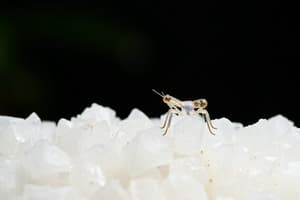Podcast
Questions and Answers
What is the general molecular formula for carbohydrates?
What is the general molecular formula for carbohydrates?
- CnH2nOn
- Cn(H2O)n (correct)
- CH2O
- C6H12O6
Which of the following is NOT a function of carbohydrates in the body?
Which of the following is NOT a function of carbohydrates in the body?
- Serving as a form of structural support
- Providing energy through oxidation
- Supplying carbon for the synthesis of cell components
- Acting as a primary component of nucleic acids (correct)
What is the name for a carbohydrate composed of two simple sugar molecules bound together?
What is the name for a carbohydrate composed of two simple sugar molecules bound together?
- Polysaccharide
- Oligosaccharide
- Disaccharide (correct)
- Monosaccharide
Which of the following is an example of a monosaccharide?
Which of the following is an example of a monosaccharide?
Based on the given text, what is the recommended daily intake of carbohydrates?
Based on the given text, what is the recommended daily intake of carbohydrates?
Which of the following sugars is NOT a disaccharide?
Which of the following sugars is NOT a disaccharide?
Which of the following is a major degradation product of starch?
Which of the following is a major degradation product of starch?
Which of the following is NOT a characteristic of amylopectin?
Which of the following is NOT a characteristic of amylopectin?
What is the primary storage form of glucose in animals?
What is the primary storage form of glucose in animals?
Which of the following polysaccharides is commonly found in plants?
Which of the following polysaccharides is commonly found in plants?
What is the primary role of glucose in the body?
What is the primary role of glucose in the body?
What is the difference between homopolysaccharides and heteropolysaccharides?
What is the difference between homopolysaccharides and heteropolysaccharides?
Which of the following disaccharides is found in milk?
Which of the following disaccharides is found in milk?
Based on its chemical structure, a pentose carbohydrate would have which molecular formula?
Based on its chemical structure, a pentose carbohydrate would have which molecular formula?
Which of the following accurately describes the structure and function of amylose and amylopectin?
Which of the following accurately describes the structure and function of amylose and amylopectin?
Which of the following statements about monosaccharides is NOT true?
Which of the following statements about monosaccharides is NOT true?
What is the main structural difference between glycogen and amylopectin?
What is the main structural difference between glycogen and amylopectin?
Which monosaccharide is considered the sweetest, with a sweetness level 73% higher than sucrose?
Which monosaccharide is considered the sweetest, with a sweetness level 73% higher than sucrose?
What is the primary difference between β-D-ribose and β-D-deoxyribose?
What is the primary difference between β-D-ribose and β-D-deoxyribose?
What is the primary function of cellulose?
What is the primary function of cellulose?
Which of the following statements correctly describes the relationship between glucose and glycogen?
Which of the following statements correctly describes the relationship between glucose and glycogen?
Which of the following is NOT a correct statement about the physical properties of monosaccharides?
Which of the following is NOT a correct statement about the physical properties of monosaccharides?
Which of the following is NOT a characteristic of cellulose?
Which of the following is NOT a characteristic of cellulose?
What is the key role of β-D-galactose?
What is the key role of β-D-galactose?
Which of the following pairs represents sugar and its relative sweetness?
Which of the following pairs represents sugar and its relative sweetness?
What type of carbohydrate is 'invert sugar' and what are its components?
What type of carbohydrate is 'invert sugar' and what are its components?
Flashcards
Carbohydrates
Carbohydrates
Biomolecules that provide energy, carbon for synthesis, and stored energy.
Monosaccharides
Monosaccharides
The simplest form of carbohydrates; single sugar molecules.
Disaccharides
Disaccharides
Carbohydrates formed by two monosaccharides bonded together.
Polysaccharides
Polysaccharides
Signup and view all the flashcards
Daily carbohydrate intake
Daily carbohydrate intake
Signup and view all the flashcards
General structure of carbohydrates
General structure of carbohydrates
Signup and view all the flashcards
Sweetness of sugars
Sweetness of sugars
Signup and view all the flashcards
Solubility of monosaccharides
Solubility of monosaccharides
Signup and view all the flashcards
Important monosaccharides
Important monosaccharides
Signup and view all the flashcards
β-D-ribose
β-D-ribose
Signup and view all the flashcards
β-D-glucose
β-D-glucose
Signup and view all the flashcards
β-D-fructose
β-D-fructose
Signup and view all the flashcards
Amylose
Amylose
Signup and view all the flashcards
Amylopectin
Amylopectin
Signup and view all the flashcards
Glycogen
Glycogen
Signup and view all the flashcards
Cellulose
Cellulose
Signup and view all the flashcards
Glycogenin
Glycogenin
Signup and view all the flashcards
Fructose
Fructose
Signup and view all the flashcards
Glucose
Glucose
Signup and view all the flashcards
Sucrose
Sucrose
Signup and view all the flashcards
Lactose
Lactose
Signup and view all the flashcards
Starch
Starch
Signup and view all the flashcards
Study Notes
Introduction to Biology - Lecture 4
- Lecture delivered by Allen Cheung on January 22, 2025
- Course: BIOL 1005 Introduction to Biology
- Lecture focused on Carbohydrates
Macronutrients
- Macromolecules categorized as Carbohydrates, Proteins, and Fats
- Key dietary components for energy and cellular function
Carbohydrates
- Sugars: Found in various foods (rice, noodles, bread, cakes, snacks)
- Body Function: Essential for cellular and bodily functions
- Brain Fuel: The brain requires glucose (110-145g per day) for proper functioning
- Daily Intake Recommendations: 225-325g per day
What are Carbohydrates?
- Classified as biomolecules alongside lipids, proteins, and nucleic acids
- Compounds of immense importance for biological processes
- Energy Source: Provide energy via oxidation
- Cell Building Blocks: Supply carbon for creating cell components
- Stored Energy: Act as stored chemical energy
- Structural Components: Part of the structures of cells and tissues
Carbohydrate Structure
- General Molecular Formula: Cn(H₂O)n (a hydrate of carbon)
- Basic Building Blocks: Monosaccharides (simple sugars) are the fundamental units
- Chain Structure: A single continuous carbon chain. Glucose structural representation can be in different forms (straight chain, ring, simplified ring).
Carbohydrate Classification
- Monosaccharides: Simplest form of carbohydrates
- Disaccharides: Two monosaccharides linked together
- Oligosaccharides: 3-10 monosaccharide units
- Polysaccharides: More than 10 monosaccharide units
Important Monosaccharides
- D-Ribose: Component of RNA (ribonucleic acid)
- D-Deoxyribose: Component of DNA (deoxyribonucleic acid)
- D-Galactose: Part of lactose, a milk sugar
- D-Glucose: Also known as dextrose or blood sugar, found in honey, fruits; crucial for energy production
- D-Fructose: Sweetest monosaccharide, found in fruits, honey, corn syrup
Physical Properties of Monosaccharides
- Sweet taste (fructose is the sweetest; 73% sweeter than sucrose)
- Solids at room temperature.
- Highly soluble in water (due to many hydroxyl groups)
Disaccharides
- Formed by linking two monosaccharides via a glycosidic bond
- Physiologically important disaccharides include sucrose, lactose, and maltose
Polysaccharides
- Composed of more than ten monosaccharides
- Types: Homopolysaccharides (one type of monosaccharide) and Heteropolysaccharides (multiple types)
- Main building block in polysaccharides is D-glucose.
Examples of Homopolysaccharides
- Starch: Storage carbohydrate in plants as granules
- Dextrin: Intermediate product in starch digestion
- Glycogen: Storage carbohydrate in animals, primarily in liver and muscle cells
- Cellulose: Main structural component in plant cell walls
- Chitin: Structural component of exoskeletons and fungal cell walls
Storage of Excess Sugars (Carbs)
- Plants store glucose as starch in their roots.
- Animals store glucose as glycogen in liver and muscle.
Starch—Composition
- Mixture of amylose and amylopectin
- Amylose: Linear glucose polymer with α(1,4) linkages
- Amylopectin: Branched glucose polymer with α(1,4) linkages and α(1,6) branch points.
Glycogen
- Storage form of glucose in animals
- Highly branched, like amylopectin, with α(1,6) branch linkages every 10 residues. Primarily stored as granules.
Cellulose
- Abundant organic molecule in nature
- Structural component of plant cell walls
- Composed of long chains of glucose monomers joined by β(1,4) linkages. This linkage is important as it cannot be digested by humans.
Summary of Carbohydrates
- Classification of carbohydrates
- Key monosaccharides and disaccharides
- Properties of different types of carbohydrates (polysaccharides)
- Storage forms of carbohydrates in plants and animals
Studying That Suits You
Use AI to generate personalized quizzes and flashcards to suit your learning preferences.




